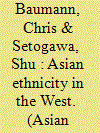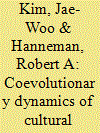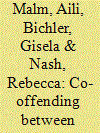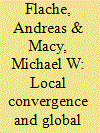|
|
|
Sort Order |
|
|
|
Items / Page
|
|
|
|
|
|
|
| Srl | Item |
| 1 |
ID:
139459


|
|
|
|
|
| Summary/Abstract |
The emergence of ethnic markets has been rapid following the growing trend of intra-national diversity in developed nations. These new markets have attracted researchers to investigate the role of ethnicity in consumer behaviour; however, to date, literature has focused on the role of the origin of tangible goods/products. In contrast, ethnic marketing for services has gained little attention. This study fills this gap by investigating the effect of ethnicity of service staff on consumers’ preferences for services. These effects are tested for the four service types identified in Lovelock’s service classification scheme. This study examined consumers’ preferences in services based on the ethnicity/racial category of service staff (Caucasian, Chinese, Indian and Korean) and service type (Medical, Education, Financial and Cleaning). A shopping mall intercept survey included a sample of 471. Multivariate analysis of variance was applied to test for significant variances between the mean preferences. Significant differences in preferences for the ethnicity of service staff were empirically established. Consumers, regardless of their ethnicity, prefer service staff of the same ethnicity. This creates a gap between preferences for one’s own ethnicity and preferences for others. This tendency was especially strong in medical services. Consumers’ preferences for service staff ethnicity are explained by the theories of country of origin, animosity, homophily and language. This study encourages service providers to make use of ethnic marketing, since a better match between service staff and customers’ preferences results in less miscommunication and better cultural understanding. Training on cultural sensitivity is also encouraged. This study establishes the important role of the country of origin in services. We name this the ‘country of origin of service staff (COSS)’ effect.
|
|
|
|
|
|
|
|
|
|
|
|
|
|
|
|
| 2 |
ID:
128977


|
|
|
|
|
| Publication |
2014.
|
| Summary/Abstract |
The emergence and institutionalization of cooperation in sizable groups without reciprocity receives considerable attention in game-theoretical modeling. Agents in our study play the Prisoner's Dilemma game cooperating with tolerably similar neighbors. They may imitate cultural markers (tags) and tolerance from more successful neighbors. Alternatively, they break ties to out-group neighbors. New partners are selected either from neighbors' neighbors (clustering) or randomly. Variations in network plasticity (the likelihood of changing partners rather than being influenced) and clustering are explored. With high plasticity and high clustering, networks tend to fragment. With low plasticity and low clustering, networks tend toward global cooperation, but with severe losses of cultural diversity and tolerance. Cooperation in such regimes also proves to be vulnerable to defection. Between, there is a space displaying relatively stable and widespread cooperation with diversity and tolerance. We note some important structural characteristics of the networks evolving in this space.
|
|
|
|
|
|
|
|
|
|
|
|
|
|
|
|
| 3 |
ID:
104329


|
|
|
|
|
| Publication |
2011.
|
| Summary/Abstract |
Rather than examining networks of individuals as prior research has done, this study systematically examines the structure and composition of co-offending among types of criminal enterprise groups. Using social network analysis, the authors show that different types of crime groups tend to have unique co-offending patterns as measured by network composition and structure. The results also support the countercurrent of criminologists who suggest that ethnically derived categories may be misleading when trying to classify criminal enterprise groups.
|
|
|
|
|
|
|
|
|
|
|
|
|
|
|
|
| 4 |
ID:
145691


|
|
|
|
|
| Summary/Abstract |
We study the effects of shocks – such as major wars that change states’ strategic environments – on alliance networks. This has important implications for the structure of security cooperation networks. We develop an agent-based model (ABM) that: (1) models network evolution processes of security cooperation networks; (2) induces shocks that cause significant changes in agents’ utilities due to shifts in common interests between states; (3) analyzes how networks reorganize in the post-shock period. We derive propositions from the ABM about the relationship between shock attributes and network structure. We compare the results of the ABM to similar shocks that operate on real-world alliance networks. The ABM results with random network data suggest that states that experience dramatic changes in their strategic environment increase network connectivity and consistency. Consequently, post-shock networks become increasingly connected (denser) and consistent (transitive). With a few notable exceptions, these results are corroborated by analysis of alliance network reorganization following shocks. We discuss the theoretical and empirical implications of the results and offer directions for future research on shocks and international networks.
|
|
|
|
|
|
|
|
|
|
|
|
|
|
|
|
| 5 |
ID:
079922


|
|
|
|
|
| Publication |
2007.
|
| Summary/Abstract |
Studies of cultural differentiation have shown that social mechanisms that normally lead to cultural convergence-homophily and influence-can also explain how distinct cultural groups can form. However, this emergent cultural diversity has proven to be unstable in the face of cultural drift-small errors or innovations that allow cultures to change from within. The authors develop a model of cultural differentiation that combines the traditional mechanisms of homophily and influence with a third mechanism of network homophily, in which network structure co-evolves with cultural interaction. Results show that in certain regions of the parameter space, these co-evolutionary dynamics can lead to patterns of cultural diversity that are stable in the presence of cultural drift. The authors address the implications of these findings for understanding the stability of cultural diversity in the face of increasing technological trends toward globalization.
|
|
|
|
|
|
|
|
|
|
|
|
|
|
|
|
| 6 |
ID:
109935


|
|
|
|
|
| Publication |
2011.
|
| Summary/Abstract |
How can minority cultures resist assimilation into a global monolith in an increasingly "small world"? Paradoxically, Axelrod found that local convergence can actually preserve global diversity if cultural influence is combined with homophily, the principle that "likes attract." However, follow-up studies showed that this diversity collapses under random cultural perturbation. The authors discovered a new source of this fragility-the assumption in Axelrod's model that cultural influence is interpersonal (dyadic). The authors replicated previous models but with the more empirically plausible assumption that influence is social-people can be simultaneously influenced by several network neighbors. Computational experiments show that cultural diversity then becomes much more robust than in Axelrod's original model or in published variations that included either social influence or homophily but not both. The authors conclude that global diversity may be sustained not by cultural experimentation and innovation but by the ability of cultural groups to discourage those activities.
|
|
|
|
|
|
|
|
|
|
|
|
|
|
|
|
|
|
|
|
|